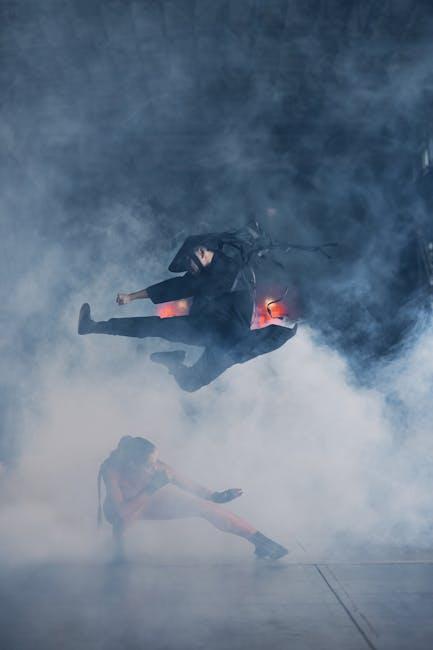In the world of cinema, where illusion becomes reality and stories leap from script to screen, the role of the actor is both celebrated and scrutinized. Among the many facets of their craft, one question lingers like a shadow in the spotlight: should actors take on the daring feats of their characters, or leave these high-risk maneuvers to the skilled hands of stunt doubles? As the boundary between performance and authenticity blurs, this debate opens a dialogue on artistry, safety, and the ever-evolving expectations of audiences. Join us as we delve into the thrilling and complex world of stunts, exploring the risks, rewards, and the fine line between reality and cinematic magic.
The Thrill and the Risk: Exploring Actors and Stunt Work
In the world of cinema, the line between reality and fiction blurs as actors dive into action-packed sequences. The idea of actors performing their own stunts can add an authentic layer to a film, making the audience feel every punch and fall. However, this practice isn’t without its risks. While some actors relish the adrenaline rush, others recognize the potential dangers involved. Stunt doubles bring a wealth of expertise, ensuring scenes are executed safely and convincingly, often saving actors from potentially career-threatening injuries.
When considering whether actors should take on more stunts, several factors come into play:
- Safety Concerns: The safety of the actor should always be paramount, with stunt professionals trained to handle hazardous situations.
- Authenticity vs. Risk: While audiences may appreciate the authenticity of an actor’s own performance, the risk factor must be weighed.
- Production Costs: Injuries can lead to delays and increased costs, impacting the entire production schedule.
- Training Time: Actors may require extensive training, diverting time from other aspects of their role preparation.
Ultimately, the decision lies in balancing the thrill of realism with the safety nets provided by the industry’s unsung heroes—the stunt doubles.

Balancing Artistry and Safety in Action Scenes
In the world of cinema, the mesmerizing choreography of action scenes often blurs the line between reality and fiction. The artistry lies not just in the breathtaking visuals, but in the seamless blend of performance and safety. When actors perform their own stunts, the audience experiences a unique authenticity. Yet, this choice comes with significant considerations. Safety protocols must be meticulously followed to prevent accidents. The collaboration between actors, directors, and stunt coordinators becomes crucial to maintain a balance between creative expression and risk management.
The use of stunt doubles offers several advantages, such as:
- Ensuring the safety of the lead actors.
- Allowing for more daring and complex sequences.
- Enabling the production to adhere to tight schedules without risking injury-related delays.
On the other hand, actors doing their own stunts can enhance the emotional depth of a scene, making the audience feel more connected to the characters. This choice can be a powerful storytelling tool, but it requires a careful consideration of the actor’s skills and the scene’s demands.

Training for the Spotlight: Preparing Actors for Stunt Roles
In the dynamic world of film, actors stepping into the realm of stunts is no longer a rarity but a growing trend. The journey from rehearsals to the final take requires not only courage but also a meticulous training regimen. Actors embarking on this path must hone a diverse skill set, often blending physical agility with the ability to perform under pressure. Here’s what this preparation typically involves:
- Physical Conditioning: Rigorous fitness routines are crucial. Actors need to build endurance, strength, and flexibility to handle the physical demands of stunts.
- Safety Training: Understanding the importance of safety gear and protocols ensures that actors can perform stunts while minimizing risks.
- Technical Skills: Learning specific stunt techniques such as falls, combat choreography, or wire work helps actors perform convincingly and safely.
- Mental Preparedness: Overcoming fear and maintaining focus are essential. Actors often work with coaches to develop the mental resilience needed for stunt work.
Training for stunt roles isn’t just about mastering physical feats; it’s about embracing a mindset that balances daring with discipline. With proper preparation, actors can bring authenticity to their performances, enhancing the cinematic experience while ensuring their safety.

When to Step Aside: Knowing the Limits of On-Screen Action
While the allure of performing one’s own stunts can be enticing, especially in the pursuit of authenticity, there are pivotal moments when actors must recognize the necessity of stepping aside. Understanding one’s limits is crucial not only for personal safety but also for the integrity of the production. Stunt doubles are trained professionals who bring years of experience and specialized skills to execute high-risk scenes safely and effectively.
- Safety Concerns: The physical risks associated with stunts can lead to serious injuries, impacting both the actor and the production timeline.
- Skill Level: Stunt performers undergo rigorous training to perfect techniques that ensure both the safety and realism of action sequences.
- Insurance Implications: Productions often face increased insurance premiums if actors insist on performing dangerous stunts without professional oversight.
Ultimately, while the thrill of performing stunts is undeniable, recognizing when to rely on the expertise of stunt doubles is a testament to an actor’s professionalism and dedication to the craft.

